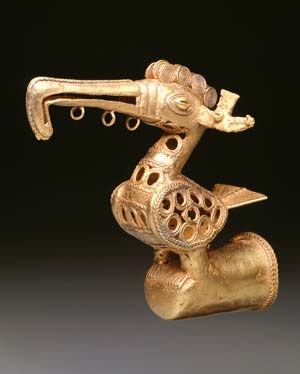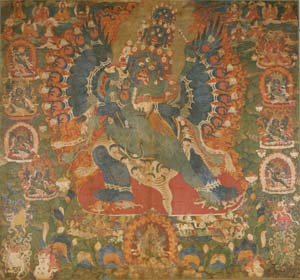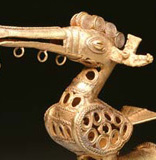A map of a museum is often set up like an atlas of humanity, bound
together by the latitudes and longitudes of truth and beauty.
This indefatigable structure promises to transcend the differences between region, religion and time. When looking at cultures other than our own, this grid also forms the structure with which we perform an ethnography of the Other.
But this grid holds within it a contraction. There is the “we are the world” attitude—in which the grid lays the groundwork for the cherubic faces of children from across the globe smile to hold hands as brothers and sisters. Then there is the multicultural approach in which each nation and ethnicity holds a particular history that is unique and fundamentally separate. These two attitudes are poles that illustrate the difficulty of curating a history of global visual culture.
As I have written before, The Dallas Museum of Art, like all museums, can be seen as an archive, from the Greek word Arkhe, meaning commencement and commandment. We are told what lies as the basis of not only our culture but also culture in general. This is particularly evident through the relationship set up between East and West, developed and developing countries, between Europe, the US and the rest of the world.
As we all remember from grammar school, Africa and the Middle East are the roots of civilization. As a result, there has been a tendency in the West to infantalize these regions, calling them primal or primitive. This perspective has also been applied to the people of Asia, the South Pacific and indigenous peoples of the Americas and Australia.
It is common for these cultures to be seen in terms of the binary of Nature/Culture. Culture resides in the West while the East preserves a close relationship to Nature. How do museums deal with the East/West divide? In particular, how does the Dallas Museum of Art deal with this? The Edward Larabee Barnes building offers a number of routes to find connections between the DMA's collections. But I want to begin at the Flora Street entrance, through the Contemporary, Modern and European galleries, walking through the West and up the stairs to find the David T. Woolsey Galleries of South Asian Art.
As the name suggests, the art objects in these galleries are either gifts or on loan from David T. Woolsey's collection. There are informative wall texts about Hinduism and Buddhism that give a context for the images of deities that populate the galleries. Right off the bat, we are reminded that “four thousand years ago, Indo-European speaking people came to India, bringing storm and sky Gods that blended with the nature spirits of fertility and power.” Despite the tendency to isolate and separate cultures it becomes clear that we are seeing fragments of what we consider to be our own culture, not just its roots but also its influence as early as 2,000 BCE. In an era when the contemporary Westernization of the East is mourned, it is interesting to note the long history of cultural influence.
Most of these sculptures originally decorated temples, believed not only in the past but also today by the 1.2 billion Hindus in the world to hold concentrations of the deity that they depict. The fact that they no longer reside in their original context is a product of the colonialism of the British Empire, which occupied India for a hundred years. Now, dislocated from their ritual origin, images of Krishna and Kali are sitting in the seemingly neutral auspices of the DMA. But is the museum as neutral as we might think?
The anthropologist, Claude Levi Strauss pointed out that the viewer saw other cultures through the lens of his own culture. Even though science seemed to be free of ideology it often brought traces of power to bear on its subjects. So as we walk through these galleries, we must be aware that both the museum and our own gaze objectifies both the art and culture of the perceived Other.
Despite their dislocation, the elegance and skill displayed in pieces like Stele of Uma-Maheshvera from 12 C. Central India is stunning. This piece depicts the deities Shiva and Parvati with their family and attendants in stone. They embody fertility and living power by sharing a loving embrace. He cups her breast. Her chin is upturned, her arm draped around his shoulders. Their child Ganesha, with elephant head and human body exudes the combination of intricate detail and large gestures of organic form.
The DMA has set up these galleries to teach us about the histories of these cultures. These ideas are structured through the seeming objectivity of a scientific perspective. By virtue of this neutrality, the art objects are presented for us to experience aesthetically. This collision of scientific fact and aesthetics is deeply rooted in a post-Enlightenment ideal that allows for truth and beauty to exist on the same plane.
But can beauty exist as a universal idea independent of cultural context? The DMA, like most Western museums, has gambled that the violence connected to the removal of these works from their origin is outweighed by the value of presenting them for scientific study and aesthetic admiration. But can beauty be neutral?
The concept of beauty has had many incarnations in the West alone. It also has many applications. Not only does beauty deal with art but it also can be applied to the form and sensuality of the human body. The explicitly sexual imagery commonly found in Hindu temples connects a particular idea of beauty in its relationship to art, the body and God. This is radically different from the American and European attitudes toward sexuality and its relationship to religion.
This became evident a few years ago with the Sensation show at the Brooklyn Museum. Former New York mayor Rudy Giuliani was furious that the artist Chris Ofilli would make a painting of the Virgin Mary using elephant dung to depict her breast. What he didn't realize and ultimately didn't care about was the fact that in Nigeria, Ofilli's place of birth, elephant dung is holy. So, we see that not only imagery but also material can hold radically different meanings, challenging an absolutely objective sense of what is both beautiful and meaningful.
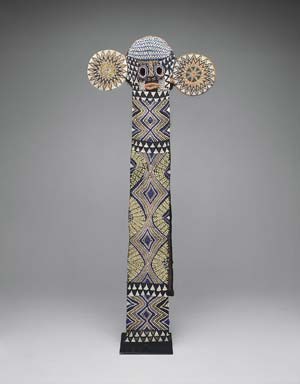
Elephant mask... Bamileke, c. 1910-1930... Palm-leaf fiber textile, cotton textile, glass beads, palm-leaf ribs, wood? 58 x 26 x 6 1/2 inches
The Buddhist art like Head of the Buddha in the Woolsey galleries is also described by the wall text to have influences from Greek, Persian and Hindu styles and that until the 3rd C. BCE, Buddhist artists were more concerned with spiritual ideals than the perceived materialism of art making. As Andre Malraux has suggested, Buddhist artists saw in Greek depictions of Apollo, a sense of freedom unlike the trap of destiny inflicted by the karmic wheel in Hinduism. This idea, while maybe suspect in its belief that the West could liberate the East, nevertheless suggests that cultures are more amalgams of various influences than the separate galleries of the museum might suggest.
Buddhist art is itself a hybrid of influences, not only from the West but also between indigenous cultures and the importation of Buddhist ideas. Thangka with Lhamo an 18th C. Tibetan gouache on cloth depicts a demon with fire for hair, five smiling skulls that bulge from his head, three eyes, blue skin and large fangs who is riding a golden horse. Like many Himalayan thangkas, this imagery combines pre-Buddhist and Buddhist demons and deities.
The galleries continue clockwise and run into the section on Islam. We are continuing through both geographic and religious territories. For instance, there are two beautiful Mogul miniature paintings including Lady Enticing a peacock with a strand of Pearls, 1800. While Indian, like some of the Hindu deities in the previous galleries they are the product of Islamic rule in Northwestern India. In keeping with tradition most of the other Islamic art objects are functional because of the prohibition against images.
Continuing clockwise, we are met with an exhibit of ancient Egyptian art including a bizarre set of Canoptic Jars, 1550-1070 BCE that hold preserved soft organs of mummies. The jars have carved heads symbolic of the sons of Horus: baboon, hawk, jackal and finally a human head. Opposite from these jars are two examples of the coffins that held the mummies. Next to this is a small set of Coptic crosses, adding another point to the Abrahamic triangle of the Middle East, the ancient kingdoms that bore the religions of Judaism, Christianity and Islam, serving as a backdrop.
The next gallery is a large exhibition of African art. This collection focuses on sub-Saharan art originally from two important collections — the Clark and Frances Stillman Collection of Congo Sculpture and the collection of Gustav and Franyo Schindler.
The wall text that serves as an introduction to these galleries reminds us of a similar issue with the South Asian art collection. “Sculpted figures were sometimes paraded in public but more often were enshrined on altars where only priests and worshipers would have seen them. A museum setting does however, allow one to focus on the form and experience the power of Africa Art” (my italics). The allusion to form's ability to transcend cultural context and serve as a vehicle for powerful experience is deeply rooted in Western thought.
As the Marxist critic Raymond Williams has explained, the idea of form has shifted its meaning with the intellectual tides of the West. In the Christian climate of 17th C. Europe, form represented the physical structure of something as opposed to its deep structure or spirit. Even in the 20th C. Russian Avant-Garde, form referred to the superficial qualities of a work as opposed to its revolutionary purpose. At the same time, Platonic form is one of many concepts that describe form as a deep structure upon which other things are built. This concept of form is the one that the DMA's wall text alludes to. Even if we were to ascribe to this attitude, one can't ignore the shifts in meaning that the idea of form has taken.
Despite the transcendence of form, we are reminded of the context from which these objects came through a set of large photographs of Africans in traditional costume. Maps and wall texts serve as excellent aides to understand Africa as a continent with enormous diversity.
There are also implicit links to the Modern galleries downstairs. Standing Reliquary Figure from Gabon's Kota peoples relates to many of the sculptures with large abstracted shapes that Picasso looked at during his involvement with cubism. Elephant Mask and Hat from the Cameroon grasslands is radically different. The hat is an explosion of bright red feathers. The mask is an intricately beaded set of patterns.
On the other side of the African galleries is the work of Oceana. Like the mask from Cameroon, there is an emphasis on flat pattern, especially in the textiles from Bali. An exception is Standing Male Figure, 1945-1955, which like the Hindu sculpture of Shiva and Parvati places an emphasis on fertility. Except in this case the two large round balls that symbolize this idea are testicles rather than breasts.
The Asian galleries are next and begin with Chinese ceramics. Pair of Lokopala c. 700-750, heavenly guardians dripping with bright orange and green glaze, stand guard over an assortment of pots ranging from the Han to the Ming dynasties. These guardians were originally meant to ward off evil spirits from tombs. Once again, this purpose has been usurped for the greater good of form and power.
Upstairs is the collection of pre Colombian art, which includes a treasure of vessels, sculpture, textiles and gold. It is here that we come full circle, returning to the soil of the Americas, if not the culture of the United States. It is in these galleries that the issue of American art rears its head. The museum's art from the Americas features ancient works from Mexico to Peru with treasures from the Olmec, Maya, Nasca, and Moche civilizations. But as we know, these civilizations were all but wiped out by European colonialists who brought both war and disease. The major artwork of the past two hundred years in both North and South America has been influenced more by Ancient Mediterranean art than these objects.
The Dallas Museum of Art has rooms and levels that divide cultures by region, religion, time period and culture. But we can see that influence is not always local. Picasso is influenced by Yoruba sculpture; North Indian Buddhist sculpture is influenced by Greek depictions of Apollo; and Egyptian portraiture was influenced by the Romans. The nature of this influence is not only stylistic but also ideological. Deep changes in culture are affected with the introduction of new visual form.
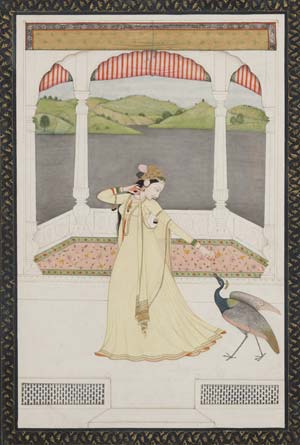
Lady enticing a peacock with a strand of pearls... c. 1800... Gouache and gold on paper... Dallas Museum of Art, gift of Michael L. Rosenberg
Given this, we could simply say that all cultures are influenced by each other, prompted by an infinite mirroring that occurs because of human nature. But this is a modernist attitude. The abstract artists in Moscow or Berlin that claimed to have found pure painting assumed that its purity meant that form was the base, upon which the superstructure of cultural details rested. This utopian hope for form as a universal language has since been shown to be false. Form is ideological and its importation has similar folly, not unlike the noble exploration of Europeans like Columbus that ran aground on American shores. MOMA's exhibition, Primitivism in 20th Century Art: Affinity of the Tribal and the Modern, provoked angry responses for this reason among others. Our valiant effort to include the world in our nurturing grasp can quickly turn to assimilation, inflicting great change on the cultures that we claim to nurture.
Form, it seems, can quickly become what Robert Smithson called a non-site. It's logical structure, while abstract, often has particular concrete ideas, which it evokes. The grid is as much a symbol as it is a tool. This is true for both aesthetic and curatorial practice. The form of the Dallas Museum of Art is not unique as far as its relationship to cultural difference. The ghosts of colonialism haunt the very structure of cultural practice.
Baudrillard's apt description of America as an astral entity – worshiping the freedom evoked by the wide-open expanse of the heartland, notes the American tendency to ignore cultural specificity. America is the great melting pot after all, isn't it?
In addition to the English backgrounds of early American artists, the DMA's collection includes artists like Jacob Lawrence who's African American identity is a result of the African Diaspora; Arshile Gorky, who came to America to escape the Armenian genocide; and probably most emblematic of the American immigrant artist there is Mark Rothko. Born in Russia, Rothko changed his name from Rothkowitz as he left his family to begin an identity of his own. But despite the change of name, his Russian Jewish identity persisted in his intellectual and artistic attitudes. The pressures to become a “normal American” reached a fever pitch in 20th C. America. America the melting pot, with Lady Liberty standing at its gates welcoming the tired, the poor and the hungry has vacillated between inclusivity and xenophobia. With the McCarthy witch-hunts, Japanese internment camps, and the racial profiling of today's war on terror, Americans have often developed a collective amnesia, forgetting our immigrant past.
So, despite the effort to create a museum, an archive that commands us to see our true beginnings and the structure of our histories, the inherent traces of influence are often more complex than we can imagine. The lens of the DMA as an American institution is always present. We see these objects through the arc of our own experience and feel the tension between the specific and the universal that constructs not only the identity of these artists but also our own.
Images courtesy of the Dallas Museum of Art.
Noah Simblist is an artist and writer who lives in Dallas and teaches at SMU.


